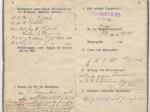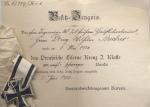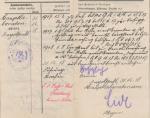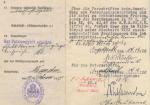-
Posts
29,251 -
Joined
-
Last visited
-
Days Won
84
Content Type
Profiles
Forums
Blogs
Gallery
Events
Store
Everything posted by Chris Boonzaier
-
Some rough text I was working on for the site ... the Prussian RESERVE Korps XV became the Bavarian R.K. The G.K. XV. b.R.K. started the war as the ?Korps Eberhardt? under the command of Gen.d.Inf. Magnus von Eberhardt. On the 1st of December 1914 it was renamed XV. Reservekorps and on the 26th of September 1916 it became the XV. bayerische Reservekorps. Less than a month after this transition, on the 16th of October 1916, Gen.d.Art. Maximilian Ritter von H?hn took over the command. The newly named General Kommando XV. bayerische Reservekorps had no fixed units under its command. As a General Kommando it was given the divisions it needed, for the task it was assigned, unlike the traditional corps system in place at the start of the war in which each corps had it's "own" divisions. For the most part the G.K. served in quieter sectors and is seldom mentioned, even in Bavarian Histories of the war. From 1914 to January 1917 the XV. b.R.K. was in the middle Vosges (Vogesen), its notable actions were: 27.1.15: Battle at Senones-Ban de Sapt (elements) 18-19.2.15: Assault on the heights south of Lusse (elements) 30.5.15: Battle at M?nil (30. R.D.) 22.6-24.7.15: Battle at Ban de Sapt (30. R.D.) 25-26.4.16: Battle on the heights north of Les Collins (30. R.D.) From mid March 1917 it was involved in positional warfare on the Aisne taking command of the bayerische Ersatz Division (b.E.D.) and the 9. and 5. bayerische Reserve Divisions (b.R.D.) to the east of Craonne. On the 16th of April 1917 it absorbed the full force of the Nivelle offensive. On the 18th of April the Generalkommando 65 replaced the G.K. XV. b.R.K. although the divisions that had been under its command remained in position for a number of days. For the rest of the war the G.K. XV. b.R.K. took part in the positional warfare in Lorraine and the Vosges General Leutnant Ritter von H?hn had started the war as commander of the 6.bayr. Infanteriedivision. In February 1915 he was appointed Chief of Staff for the 3. A.O.K. He remained in this position until late September of that year, participating in the defensive fighting in the Champagne. A run in with von Falkenhayn had caused him to be transfered (seen by him and his superiors as a ?soft demotion?) and he took command of the 2. Garde Infanterie Division on the 26th September 1915. The details of this argument are recounted by Generaloberst von Einem in his book "Ein Armeef?hrer erlebt den Weltkrieg" and von Einem was of the opinion that von H?hn was a capable officer who ran afoul of a superior who was not capable of taking advice. Von H?hn commanded the 2. G.I.D. in the Roye-Noyon area until May of 1916. On the 10th of July 1916 he took command of his old division, the 6. Bayer. Infanterie-Division until assuming command of the G.K. XV. b.RK on 16 Oct 1916. On the 8th of August 1918 he was replaced by GenLt. Paul Ritter von Kneussl. It is interesting to note that after the experiances gained by the Germans in their defensive battles in 1915 and 1916 von H?hn favoured an even more flexible system of defence than had been introduced by L?dendorff. While the standard orders for the defensive battle allowed a divisional commander to act only within his sector, all withdrawls and counter attacks taking part on a local, tactical level, von H?hn had proposed to evacuate large portions of the front during the enemy preperation and to "attack the attackers" in Armee strength when the offensive started. This was not approved as the German high command was worried that the French may gain a foothold and that their own troops may fail in retaking the ground they had abandoned.
-
Hi Bob, From the time he took his oath, went through training and was badly wounded, one month and 25 days went buy. He was in hospitals and rehab till 16. The entry was for the Ersatz bataillon of 103 where he landed after his wound until he prossesed out. He was in combat with the 242 RIR in the 53 R.D. which was one of the "slaughter" regiments. Bottom left marked in red you can see he was let out in 16 with a 30% dissability. Other than the address page and family details there are no more entries to the book. It is typical for books of guys killed or wounded right at the beginning of their "careers" There is a pretty good book on the "innocents" Korps called "Langemarck" by Karl Unruh. best Chris
-

EK 1914 Pretty rare lil thingy...
Chris Boonzaier replied to Chris Boonzaier's topic in Germany: All Eras: The Iron Cross
After the war he got the White ribboned cross for the homefront, a rare Bavarian version of the award doc... -

EK 1914 Pretty rare lil thingy...
Chris Boonzaier replied to Chris Boonzaier's topic in Germany: All Eras: The Iron Cross
Somehow related to the M.A.N. factory (which made my MG 08/15) he served at the "Head Lab" (Which was a huge ammunition maker) till the end of the war... -

EK 1914 Pretty rare lil thingy...
Chris Boonzaier replied to Chris Boonzaier's topic in Germany: All Eras: The Iron Cross
According to his Pass he recieved no military training... and landed up at the end of the war in the Hauptlaborotorium in Ingolstadt... -

EK 1914 Pretty rare lil thingy...
Chris Boonzaier posted a topic in Germany: All Eras: The Iron Cross
Here is a cross to a man who was pulled into an Eisenbahn erstaz unit for a month or so at the end of 1916. Milit?rpass for Eisenbahntruppen... was done as "Pionier" then as "Ingenieur ??" -

EK 1914 "Deutscher Offiziersverein" EK1
Chris Boonzaier replied to Motorhead's topic in Germany: All Eras: The Iron Cross
Can it be that there is a gegenplatte that goes between the cross and screws? Best Chris -

EK 1914 Unmarked EK1
Chris Boonzaier replied to Steve campbell's topic in Germany: All Eras: The Iron Cross
a nice cross indeed!! I think I have one of these stamped 800 -

EK 1914 The Makers marks......
Chris Boonzaier replied to Chris Boonzaier's topic in Germany: All Eras: The Iron Cross
Hi, I am pretty confident that someone just matched a FR from a cross to a name they had heard in connection with stamped WW2 badges. Frank and Reif is a stamping company who stamped out badges in WW2, they did not have the skills to do EKs even then. best Chris -

EK 1914 The Makers marks......
Chris Boonzaier replied to Chris Boonzaier's topic in Germany: All Eras: The Iron Cross
Hi, not so long ago a phonecall to Frank and Reif determined that 1) they did not make WW1 EKs, 2) the company did not exist under the name back in WW1. So we can even knock the FR out of the equation. Another thing to factor in.... Many pieces were assembled by Jewellers... Did they stamp their own rims? Did they order them from a stamping firm? Did a company who stamped out silver rims also cast iron centers for the cross? it is two different kinds of process..... Could it be that there were rim wholesales and iron center wholesalers and companys who bought and assembled the parts? -
Will we ever REALLY know who made what cross.... I get the feeling that all the WW1 losts of makers are simply guessed. i.e. we see a ring stamp, and by chance know a matchiing maker/Jeweller name.... so suddenly "AB in a box" becomes Anton Brunhilde simply because we happen to put the two together.... How many of the lits are really "right" ?
-
OK, the XVI A.K. was NOT Bavarian.... BUT, after they had suffered incredible losses at verdun the Alpenkorps (It is a J?ger hat) moved into the XVI A.K. for a month or so to recuperate. I suppose it is logical that the resupply would have come over the Korps B.A. that they were attached to. Hence a BA XVI stamp in a Bavarian hat. Is my logic OK on that? Thanks Chris.
-

EK 1914 1914 EKII mm "square"
Chris Boonzaier replied to buellmeister's topic in Germany: All Eras: The Iron Cross
I think TomY has a brass frame one as well... maybe with a stamp?








